A trial balance is a report that provides a list of the balances of all active general ledger accounts of a company as of a specific date. The balances of each account are displayed in debit and credit columns.
Before preparing financial statements, an accountant runs this report, usually at the end of the accounting period, to ensure that the debits and credits are equal. The rule is that every transaction has a dual effect: each debit has a corresponding credit and vice versa. Once the trial balance is reconciled, the financial statements can be created.

The Role of the Trial Balance in the Year-End Closing
Accountants run the trial balance report as part of the month-end and year-end closing processes to ensure that the total debit matches the total credit. This process is necessary to produce an accurate financial statement.
The following are the primary goals of the trial balance:
- Ensure the accuracy of ledger postings by testing the equality of debits and credits
- Help identify any posting errors
- Serve as the basis for the preparation of financial statements
- Assist auditors, who use the year-end adjusted trial balance report to begin their audit
Note that NetSuite does not allow users to enter unbalanced entries, so the first item applies only to businesses that use manual record-keeping.

Using Rules
Using Rules
Types of Trial Balance Reports
A trial balance report is created in three stages in accounting:
The table below shows the normal balance of each general ledger account in the Trial Balance report. Note that each general ledger account has a sub-ledger account that is used to post transactions into NetSuite.
NetSuite does not indicate whether or not a trial balance report has been adjusted. Once the adjusting entries are made, it will simply convert the report from an unadjusted trial balance to an adjusted trial balance report.
NetSuite Trial Balance Report Navigation
There are two ways to open a trial balance report in NetSuite. The first is to navigate to Reports > Financial > Trial Balance.
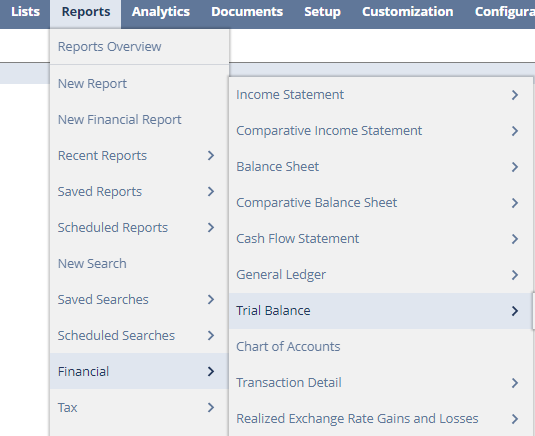
The second method is by simply typing the word “trial balance” in the Search box in the upper middle part of the page, then selecting Page: Trial Balance.

The bottom section of the screen shows different fields and icons with various functions.

Filter Fields
The following fields are used to filter the data in the trial balance report:
- End Of: This field filters data based on period, quarter, or year.
- As Of: This field filters data as of the selected date.
- Subsidiary Context: This field helps filter data to show the details of only a selected subsidiary. There is also an option to select the consolidated data of all subsidiaries.
- View: This field represents the columns shown in the trial balance. There are two options: Debit/Credit displays the debit and credit balances for each account in two columns, while Total shows the balance of the debits and credits for each account in a single column.
To show the filtered data, click the Refresh button.

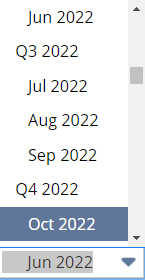

Icons
The following icons can help you better analyze the report.

The following is an explanation of the icons, from left to right:
- Options: Used to format the report's view. Users have the option to select a plain report or a report with grid lines.
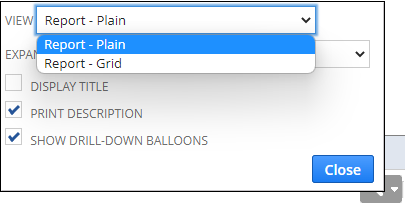
- Collapse: Hides sub-ledger accounts immediately.
- Expand: Expands the report to show both the main accounts and their sub-ledger accounts.
- Graph: Creates a graphical representation of the report based on the selected data.

- Export - Microsft Excel: Exports the report in excel format.
- Export - PDF: Exports the report in PDF format.
- Export - CSV: Exports the report in CSV format.
- Export - Microsoft Word: Exports the report in Word format.
- Print All: Prints all the data on the screen immediately.
- Email: Emails the trial balance report to a selected recipient. Users can send it both internally and externally. Users must manually enter the recipient’s email address to send the report externally. There is also an option to add a message and attach more files.

- Schedule: Used to set a specific date and time for running the report. Users have the option to run the report more than once. If this field is enabled, users can opt to run the report daily, weekly, monthly, or annually. Additionally, the recipient's name and email address must be included.
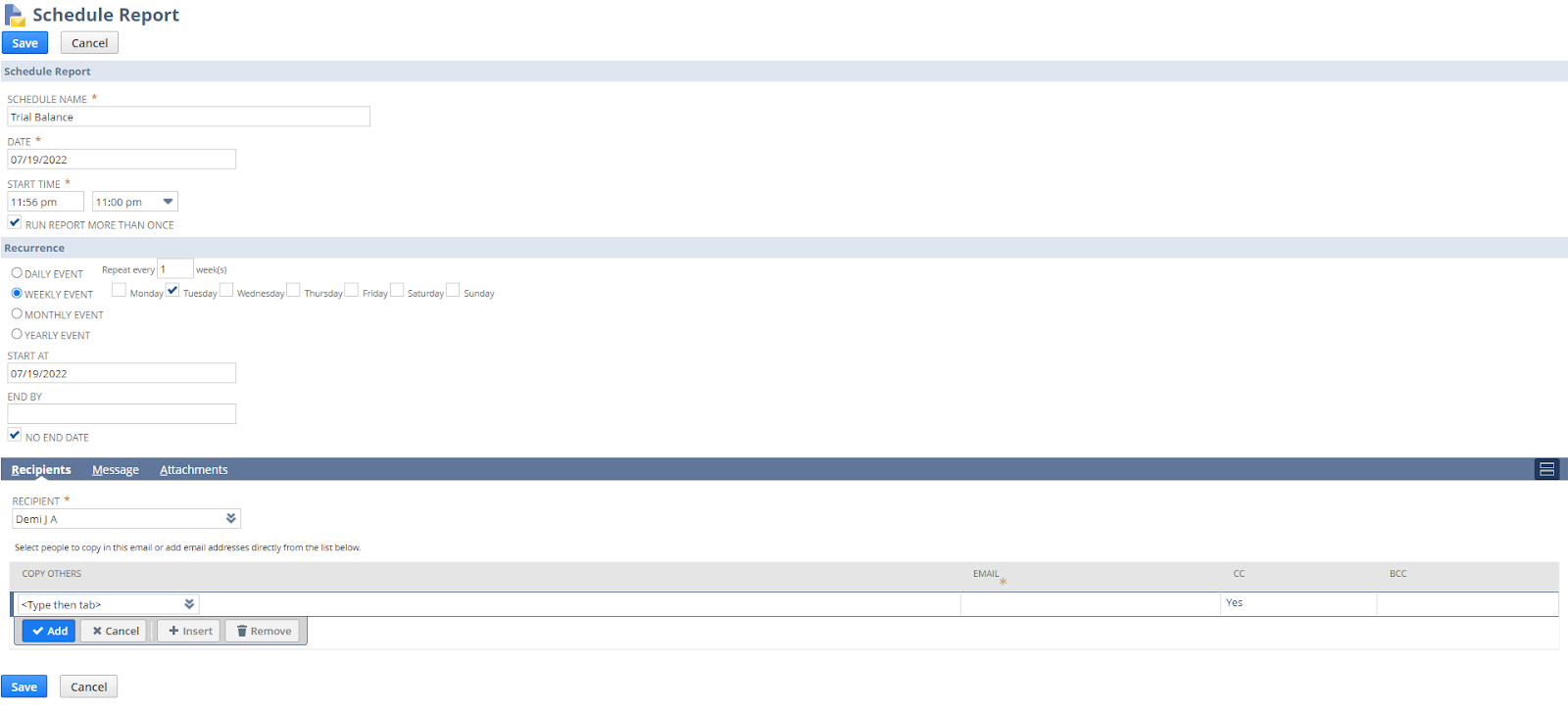
Customization
The Customize field will take users to a Report Builder page where they can create a new report format based on their requirements.

Errors in the Accounting Process
When there is a mismatch between the totals of debits and credits, this indicates an error in the recording or posting of entries. Some errors could include the following:
- Uneven debit and credit entries in a journal
- Incorrectly posting to an account's debit or credit
- Footing the account balance or trial balance incorrectly
- Transferring an incorrect amount from the ledger to the trial balance
- The account balance being listed on the wrong side of the trial balance
The following errors will not be detected by a trial balance but rather by a careful review of the records:
- Failure to document a transaction or event
- A transaction or event being recorded and posted multiple times
- Entries or postings to the incorrect account
- Entries and postings being reversed
- Amounts with transposition and trans-placement errors being recorded and posted
If the balance is higher or lower than expected, click the amount to review the transactions included in the account balances. This will direct the users to the Account Detail page that will provide the transaction details such as date, document number, supplier or customer name, and amount.

The entry of each transaction can also be checked by clicking the transaction amount, then going to the Actions Tab and selecting GL Impact.
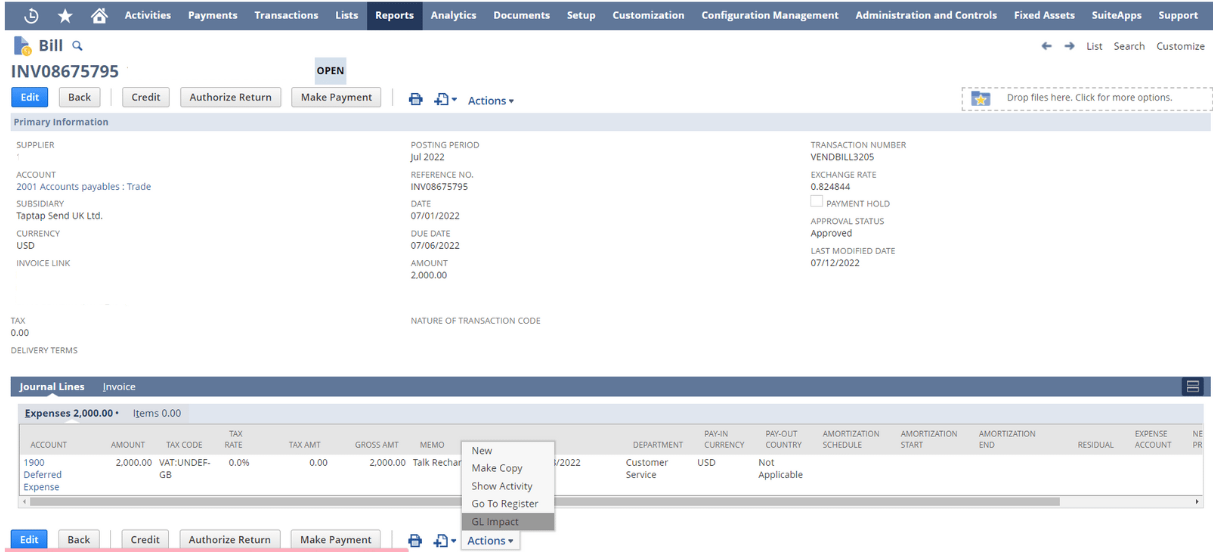

Tips to Achieve a Balanced and Accurate Trial Balance Report in NetSuite
Follow these tips to generate an accurate and balanced trial balance report:
- To avoid an error like failing to document a transaction in NetSuite, enter the transaction as soon as it is received.
- Utilize NetSuite's different approval workflow levels to ensure that all transactions are carefully reviewed and approved.
- Perform a duplicate review to check if any transactions were entered more than once.
- To avoid errors due to transposition when posting the transactions, it is better to copy the data from the source document rather than manually typing it.
- Make a list of accounts that are expected to have adjusting entries at the end of the accounting period so that they are not overlooked.
Conclusion
The primary objective of the trial balance is to verify that the balances of all active accounts, both debit, and credit, are consistent with one another. It can help determine if there is something wrong with posting transactions. However, it cannot capture everything, so it is still necessary to carry out a careful and comprehensive check before and after entering the transaction into NetSuite.







